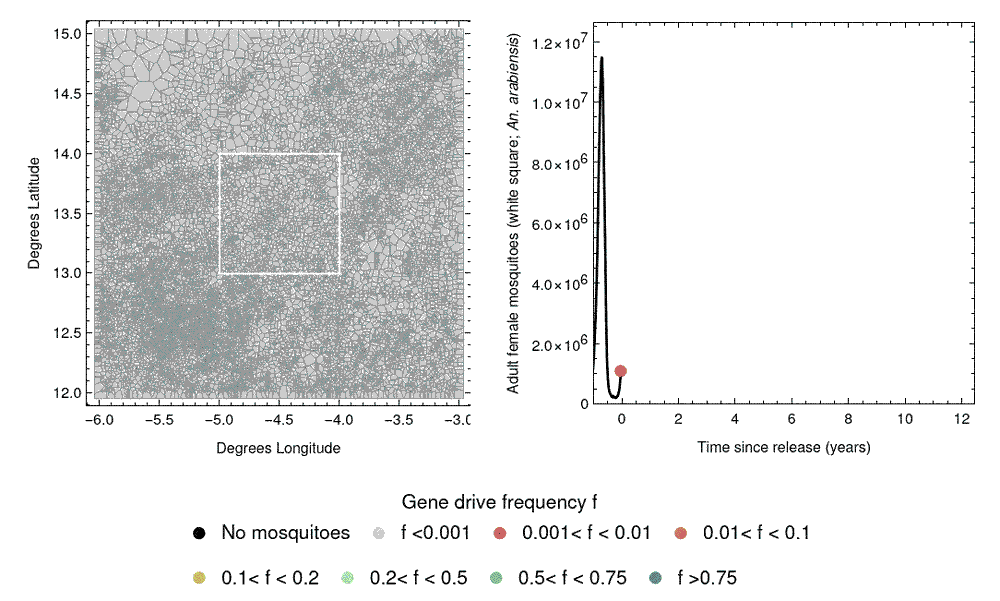Predicting the potential of gene drives in mosquitoes to control malaria in West Africa with mathematical models


Researchers from Target Malaria UK have published a new mathematical modelling study investigating the potential epidemiological impacts of gene drive releases in West Africa: “The potential of gene drives in malaria vector species to control malaria in African environments”. The paper has been published in Nature Communications.
One of the main findings was that gene drives need to be released in multiple species of malaria transmitting mosquito to strongly reduce clinical malaria cases.
We also demonstrated the potential of gene drives to substantially boost malaria control when used in combination with new bed net products and vaccines, with at least 60% more clinical cases averted when gene drives were added.
What did the study do?
Gene drive technologies could be transformative in malaria control, reducing populations of malaria-transmitting mosquitoes through self-sustaining population suppression. In real environments, however, gene drive impacts will depend on local ecological and epidemiological factors.
We developed mathematical models to predict the impacts of gene drives on the malaria burden across sixteen locations within West Africa, distributed across thirteen countries. The locations differed with respect to their landscape features, climate, the mosquito species present, the prevalence of malaria and the usage of insecticidal interventions, drug treatments and vaccines among human populations.
What were the results?
Gene drive mosquitoes were predicted to spread spatially from the initial release location, resulting in temporary eliminations of the targeted mosquito species followed by re-colonisations. The targeted vector species was not permanently eliminated from the region, but its abundance was strongly suppressed by about 72%-92%.

We found that the impact on malaria incidence depended strongly on the mosquito species targeted. To achieve a strong impact (90% of malaria reduction in all areas), the models show that we need to release genetically modified mosquitoes on the four most important vector species in that region: Anopheles gambiae, An. coluzzii, An. arabiensis, and An. funestus.
When only the two major vector species An. gambiae and An. coluzzii were targeted, average reductions in prevalence ranged from no reduction to 72% across areas, and reductions in cumulative clinical cases ranged from zero to 57%.
When combined with two other new malaria control interventions, RTS,S vaccination and pyrethroid-PBO bed nets, the addition of gene drive mosquitoes further increased the numbers of cases averted by 60% to 97% depending on the location and species targeted.
The results were also sensitive to the precise properties of the modified gene, such as the fertility of females that carry one copy. Further laboratory and field experiments will indicate more precisely if the gene drive mosquitoes are able to reduce sufficiently the population of wild type mosquitoes to stop the transmission of malaria.
How can we interpret these results?
Gene drive mosquitoes have the potential to strongly reduce malaria transmission in African countries, but their impacts vary depending on where they are applied and which mosquito species they target. They could substantially boost malaria control if used as part of integrated approaches involving multiple interventions, such as drugs, insecticides and vaccines.
Our models highlight several uncertainties about gene drive impacts, where further field studies of malaria-transmitting mosquitoes will be required, if gene drive mosquitoes are to be considered for malaria control. Our analyses assume that mosquitoes do not develop resistance to the gene drive. Our colleagues involved in the development of gene drive mosquitoes are developing approaches to reduce the likelihood of resistance evolution and to prolong the effectiveness of gene drive release interventions for malaria control.
Mathematical modelling is an important tool at Target Malaria to help us to understand the potential impacts of gene drive mosquitoes. In this publication, we have used models to investigate potential gene drive releases in a wide variety of West African environments. We found that releasing multiple vector species responsible for transmission may achieve strong epidemiological impacts.
